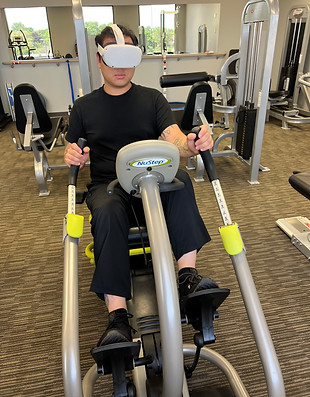
Our Clinical Applicaitons are based on extensive clinical trials and evidence based research.
A modern, evidence-based approach to address the delivery of healthcare solutions employing our (Patent Pending) applied technologies, artificial intelligence, augmented reality, virtual reality and immersive environments!
-Innovative and Individualized programs are designed for all conditions involving the joints, the spine, upper and lower extremities, muscle weakness, poor coordination and balance, chronic pain, posture and gait disturbances, neurological problems, anxiety, poor mobility and function, cognition and basic activities of daily life.
SSIT also specializes in rehabilitation of amputee patients and the Soldiers to get back to the society and life, overcoming physical injuries and mental trauma due to PTSD. By creating a safe and interactive virtual program which stimulates the brain and muscle action coordination we can achieve immense improvement in balance and function.
Revolutionary Use of VR in Amputee Patients.
SSIT is a leading medical provider in treating amputee patients with its revolutionary VR Immersive environments. Our specialized and proprietary VR Immersive environments can be customized to meet the needs of any kind of amputee patients and their families.


The Potential of VR for Treating Military Injuries and PTSD. Virtual reality (VR) immersive environments have shown promise in treating military injuries and post-traumatic stress disorder (PTSD).
AT SSIT, We are Pioneers in Exploring Potential of our Customized Virtual Reality Environments for Treating Military Injuries and PTSD
Virtual reality (VR) immersive environments have shown promise in treating military injuries and post-traumatic stress disorder (PTSD). Here are some ways VR can be used:
1. Exposure Therapy:
-
Simulating Traumatic Events: VR can recreate the traumatic events experienced by soldiers, allowing them to face their fears in a controlled environment.
-
Gradual Exposure: By gradually exposing individuals to the traumatic memories, they can learn to manage their anxiety and fear responses.
2. Pain Management:
-
Distraction: VR can provide a distraction from physical pain, helping soldiers cope with their injuries.
-
Mindfulness Techniques: VR can be used to guide soldiers through mindfulness exercises, which can reduce pain perception.
3. Cognitive Behavioral Therapy (CBT):
-
Skill Building: VR can be used to practice cognitive and behavioral skills, such as relaxation techniques and problem-solving strategies.
-
Social Anxiety: VR can simulate social situations, helping soldiers with social anxiety to overcome their fears.
4. Physical Rehabilitation:
-
Virtual Environments: Soldiers can engage in physical therapy exercises in virtual environments, making rehabilitation more engaging and effective.
-
Goal-Oriented Tasks: VR can provide goal-oriented tasks that can motivate soldiers to work harder and achieve better outcomes.
5. Mental Health Support:
-
Relaxation and Mindfulness: VR can be used to guide soldiers through relaxation and mindfulness exercises, promoting mental well-being.
-
Social Connection: VR can create virtual social environments where soldiers can connect with others who have similar experiences.
Key Benefits of VR for Military Injuries and PTSD:
-
Controlled Environment: VR allows for controlled exposure to traumatic memories, reducing the risk of re-traumatization.
-
Personalized Treatment: VR can be tailored to the individual needs of each soldier, providing a more effective treatment approach.
-
Engaging and Immersive: VR can make therapy more engaging and enjoyable, increasing adherence to treatment.
Note:
While VR has shown promising results, it's important to note that it is not a cure-all. It should be used in conjunction with other evidence-based treatments and under the guidance of mental health professionals.
Would you like to know more about specific VR applications for military injuries and PTSD, or about the research supporting its use?







